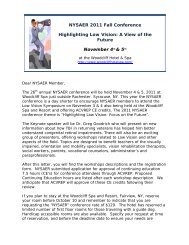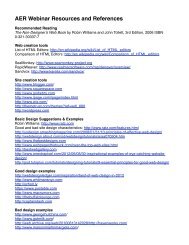Association for Education and Rehabilitation of the ... - AER Online
Association for Education and Rehabilitation of the ... - AER Online
Association for Education and Rehabilitation of the ... - AER Online
Create successful ePaper yourself
Turn your PDF publications into a flip-book with our unique Google optimized e-Paper software.
Teacher Self-Efficacy <strong>and</strong> Deaf-Blindness<br />
attitudes toward children with deaf-blindness. These<br />
factors appeared to mediate teachers’ sense <strong>of</strong><br />
efficacy. In addition, <strong>the</strong> data showed that teachers,<br />
in <strong>the</strong> absence <strong>of</strong> education <strong>and</strong> experiences<br />
teaching a diverse <strong>and</strong> challenging group <strong>of</strong><br />
students, need specific supports that are varied<br />
<strong>and</strong> particular to <strong>the</strong>ir situations.<br />
Limitations<br />
There were many limitations to this investigation<br />
<strong>of</strong> teacher SE in deaf-blindness. For one, this was a<br />
pilot study <strong>and</strong>, as such, marks <strong>the</strong> first attempt at<br />
underst<strong>and</strong>ing <strong>the</strong> construct <strong>of</strong> SE as it relates to<br />
teaching children with deaf-blindness. In addition,<br />
<strong>the</strong> composition <strong>of</strong> <strong>the</strong> group <strong>of</strong> 13 teachers chosen<br />
<strong>for</strong> <strong>the</strong> study may have contributed to <strong>the</strong>mes that<br />
emerged <strong>and</strong> <strong>the</strong> stated findings. The purposeful<br />
sampling technique used in <strong>the</strong> selection <strong>of</strong> <strong>the</strong><br />
teachers yielded rich data <strong>for</strong> analysis, but it is not<br />
possible to know how <strong>the</strong>se teachers compare or<br />
contrast to o<strong>the</strong>rs that support learners with deafblindness.<br />
Despite <strong>the</strong>se limitations, this study<br />
identified <strong>the</strong>mes that are useful <strong>for</strong> our underst<strong>and</strong>ing<br />
<strong>of</strong> <strong>the</strong> concept <strong>of</strong> teacher SE <strong>and</strong> provides<br />
a foundation <strong>for</strong> future research on teacher efficacy<br />
<strong>and</strong> <strong>the</strong> contextual factors that may mediate it.<br />
Future research could replicate this study using a<br />
different group <strong>of</strong> teachers with varying backgrounds.<br />
Conclusion<br />
Teachers who support children with deafblindness<br />
are a useful population <strong>for</strong> <strong>the</strong> study <strong>of</strong><br />
SE given <strong>the</strong> unique challenges <strong>the</strong>y face in<br />
educating a low-incidence population <strong>of</strong> learners<br />
with unique <strong>and</strong> specialized needs. Perhaps <strong>the</strong><br />
fact that <strong>the</strong>re are so few children with deafblindness<br />
<strong>and</strong> so few teachers trained to teach<br />
<strong>the</strong>se children is one reason why researchers <strong>of</strong> SE<br />
can study factors that mediate varying levels <strong>of</strong><br />
teacher efficacy <strong>and</strong> <strong>the</strong> contextual factors that<br />
affect <strong>the</strong>se levels. Teachers supporting children<br />
with deaf-blindness must go beyond <strong>the</strong> resources<br />
<strong>the</strong>y currently have, including <strong>the</strong>ir education,<br />
training, <strong>and</strong> past teaching experiences, <strong>and</strong> take<br />
a problem-solving approach to instructing <strong>the</strong>se<br />
children. A highly individualized <strong>and</strong> collaborative<br />
approach to support children with deaf-blindness is<br />
warranted.<br />
The <strong>the</strong>oretical implications <strong>of</strong> this study were<br />
limited, but analyses revealed that factors within<br />
teachers’ environments <strong>and</strong> <strong>the</strong>ir own experiences<br />
affect <strong>the</strong>ir sense <strong>of</strong> efficacy, which is consistent with<br />
<strong>the</strong> model <strong>of</strong> teacher efficacy presented by<br />
Tschannen-Moran et al. (1998). Future research<br />
could investigate how teachers <strong>for</strong>mulate <strong>and</strong> sustain<br />
<strong>the</strong>ir efficacy beliefs across a career (Tschannen-<br />
Moran & Woolfolk Hoy, 2002) or how teachers’<br />
efficacy beliefs vary when supporting certain<br />
subgroups <strong>of</strong> children with deaf-blindness (e.g.,<br />
infants/toddlers or children with CHARGE syndrome).<br />
Fur<strong>the</strong>r research on teacher SE beliefs in a variety <strong>of</strong><br />
contexts <strong>and</strong> with a variety <strong>of</strong> students, such as<br />
children with deaf-blindness, may contribute to this<br />
growing corpus <strong>of</strong> work.<br />
Practical Implications<br />
The findings <strong>of</strong> this study may have practical<br />
implications <strong>for</strong> those interested in teacher education,<br />
on a preservice <strong>and</strong> in-service level, in special<br />
education. The issues <strong>and</strong> factors that <strong>the</strong> teachers<br />
discussed in <strong>the</strong>ir interviews appear to affect <strong>the</strong>ir<br />
judgments <strong>of</strong> <strong>the</strong>ir abilities to teach. Perhaps future<br />
research could study if teachers’ SE is affected by<br />
providing educators resources <strong>and</strong> supports to<br />
effectively teach <strong>the</strong>se children. For example, does<br />
teachers’ SE change when administrators give extra<br />
release time or decrease <strong>the</strong> caseloads <strong>of</strong> individual<br />
education plan (IEP) team members <strong>of</strong> children with<br />
deaf-blindness? What happens to teachers’ SE to<br />
support children with deaf-blindness if <strong>the</strong>y meet more<br />
frequently to collectively solve issues <strong>and</strong> support<br />
each o<strong>the</strong>r? When outside agencies with specific<br />
expertise in deaf-blindness support IEP teams <strong>of</strong><br />
children with deaf-blindness <strong>and</strong> provide <strong>the</strong>m with <strong>the</strong><br />
on-<strong>the</strong>-job support <strong>the</strong>y need, does it affect <strong>the</strong>ir<br />
judgments <strong>of</strong> <strong>the</strong>ir capacities?<br />
Acknowledgments<br />
This study was funded by <strong>the</strong> Spencer Foundation<br />
<strong>and</strong> presented at <strong>the</strong> annual meeting <strong>of</strong> <strong>the</strong> American<br />
Psychological <strong>Association</strong> in San Francisco, CA,<br />
August 2007.<br />
References<br />
96 | <strong>AER</strong> Journal: Research <strong>and</strong> Practice in Visual Impairment <strong>and</strong> Blindness<br />
Ashton, P. (1984). A motivational paradigm <strong>for</strong> effective<br />
teacher education. Journal <strong>of</strong> Teacher <strong>Education</strong>, 5, 28–32.







